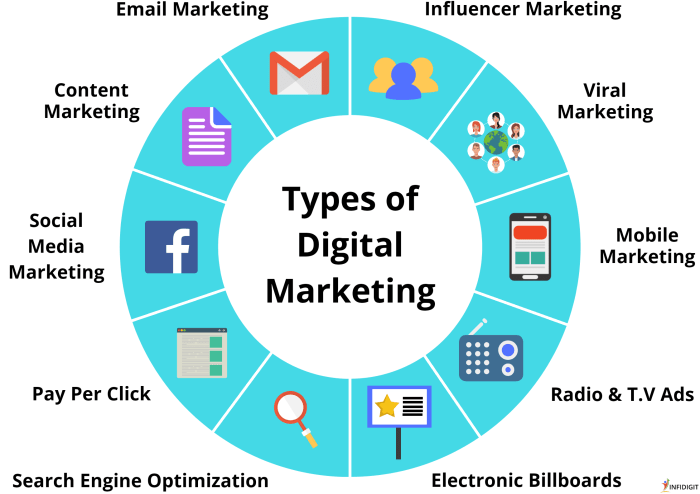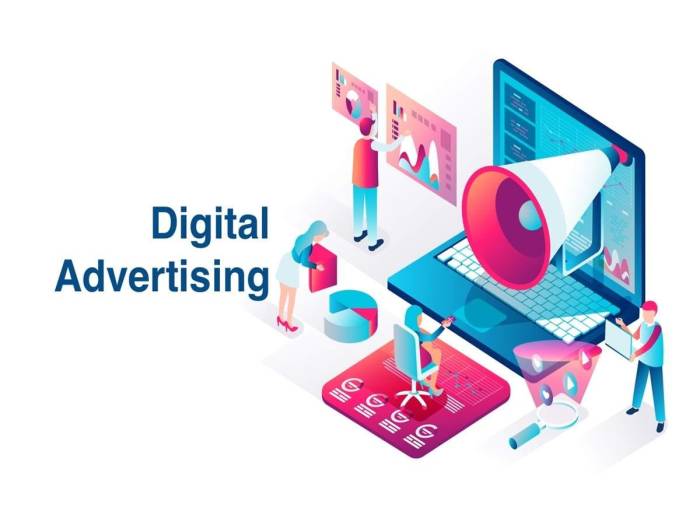Digital Advertising Basics takes center stage in the digital realm, where social media, search engines, and creative strategies collide to shape the marketing landscape with a hip twist. Get ready to dive into the fundamentals of this dynamic world!
Definition of Digital Advertising: Digital Advertising Basics

Digital advertising is a form of marketing that utilizes digital channels to promote products or services to a target audience. Unlike traditional advertising, which includes mediums like print, radio, and television, digital advertising leverages online platforms to reach potential customers.
Digital Advertising Channels
- Social Media: Platforms like Facebook, Instagram, and Twitter allow businesses to create targeted ads based on user demographics and interests.
- Display Ads: These are visual ads that appear on websites and can be in the form of banners, pop-ups, or video ads.
- Search Engine Marketing: This involves placing ads on search engine results pages to drive traffic to a website based on specific s.
- Email Marketing: Sending promotional messages or newsletters to a list of subscribers via email.
Importance of Digital Advertising
Digital advertising is crucial in today’s market landscape due to the increasing reliance on the internet and digital devices. Consumers spend a significant amount of time online, making digital channels an effective way to reach and engage with them. Additionally, digital advertising offers advanced targeting options, real-time analytics, and the ability to track the performance of campaigns, providing valuable insights for businesses to optimize their marketing strategies.
Key Components of a Digital Advertising Strategy
In the world of digital advertising, having a solid strategy is crucial for success. Let’s dive into the key components that make up a successful digital advertising strategy.
Target Audience Segmentation
Target audience segmentation plays a vital role in digital advertising. By dividing your audience into specific segments based on demographics, behavior, interests, and other factors, you can tailor your ads to meet the needs and preferences of each group. This personalized approach increases the chances of engaging your audience and driving conversions.
Ad Creatives, Ad Copy, and Ad Placement
Ad creatives, ad copy, and ad placement are essential components of any digital advertising campaign. The ad creative is the visual aspect of your ad, including images, videos, or graphics, which grab the attention of your audience. The ad copy, on the other hand, is the written content that conveys your message and persuades the audience to take action. Lastly, ad placement refers to where your ads are displayed, whether it’s on social media, search engines, websites, or other digital platforms. The strategic placement of your ads can significantly impact their performance and reach.
Types of Digital Advertising Campaigns

Digital advertising campaigns come in various forms, each with its unique strengths and strategies. Let’s delve into the different types of digital advertising campaigns and how they can be utilized effectively.
Pay-Per-Click (PPC) Advertising
PPC advertising involves paying a fee each time your ad is clicked. It is a popular form of digital advertising used on search engines like Google and social media platforms like Facebook. The key advantage of PPC is its ability to drive targeted traffic to your website quickly.
Social Media Advertising, Digital Advertising Basics
Social media advertising involves creating and sharing content on social media platforms to promote your products or services. Platforms like Instagram, Facebook, and Twitter offer a variety of ad formats to engage with users effectively. Social media ads can be highly targeted based on demographics, interests, and behaviors.
Influencer Marketing
Influencer marketing involves collaborating with influencers to promote your brand or products. Influencers have a loyal following and can help you reach a specific audience authentically. This type of digital advertising is effective in building credibility and trust with consumers.
Display Advertising
Display advertising includes banner ads, pop-up ads, and other visual ads placed on websites, apps, or social media platforms. These ads can be static or interactive and are used to increase brand visibility and awareness. Display ads can be targeted based on user behavior and interests.
Video Advertising
Video advertising involves creating and sharing video content to promote your brand or products. Video ads can be displayed on platforms like YouTube, Facebook, and Instagram. Video ads are engaging and can effectively communicate your message to the audience.
Search Engine Marketing (SEM)
SEM involves promoting your website by increasing its visibility in search engine results pages through paid advertising (PPC) and search engine optimization (). SEM helps drive organic and paid traffic to your website, increasing brand awareness and conversions.
Email Marketing
Email marketing involves sending commercial messages to a group of people via email. It is a cost-effective way to reach a targeted audience and nurture leads. Email marketing campaigns can be personalized and automated to deliver relevant content to subscribers.
Setting clear objectives and KPIs for digital advertising campaigns is crucial for measuring success and optimizing performance. Define specific goals such as increasing website traffic, generating leads, or boosting sales. Track key metrics like click-through rates, conversion rates, and return on ad spend to evaluate the effectiveness of your campaigns.
Targeting and Personalization in Digital Advertising
Targeting in digital advertising refers to the practice of directing marketing efforts towards a specific group of people who are more likely to be interested in your products or services. This strategy helps advertisers reach the right audience, increasing the chances of conversion and maximizing the return on investment.
Role of Personalization
Personalization plays a crucial role in creating tailored ad experiences for users. By analyzing user data, such as browsing history, demographics, and online behavior, advertisers can deliver customized content that resonates with individual preferences. This not only enhances user engagement but also improves the overall effectiveness of digital advertising campaigns.
- Customized Recommendations: Websites like Amazon and Netflix use personalization algorithms to recommend products or movies based on user preferences and past interactions.
- Dynamic Ads: Brands like Nike and Coca-Cola leverage personalization to display targeted ads to different segments of their audience, showcasing products that align with their interests or previous purchases.
- Location-Based Targeting: Local businesses use geotargeting to display ads to users in specific geographic locations, increasing the relevance of their promotions and driving foot traffic to physical stores.